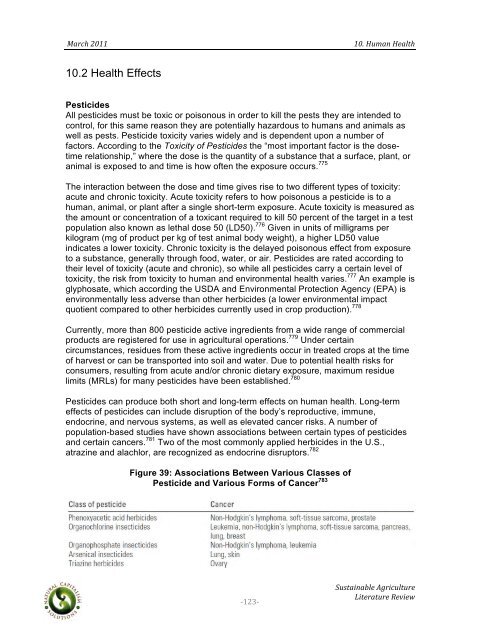Sustainable Agriculture Literature Review - Boulder County
Sustainable Agriculture Literature Review - Boulder County
Sustainable Agriculture Literature Review - Boulder County
You also want an ePaper? Increase the reach of your titles
YUMPU automatically turns print PDFs into web optimized ePapers that Google loves.
! !!<br />
"#$%&!'())!! !!!!!!!!!!!!!!!!!!!!!!!!!!!!!!!!!!!!!!!!!!!!!!!!!!!!!!!!!!!!!!!)(+!03B#5!01#/2&!<br />
10.2 Health Effects<br />
Pesticides<br />
All pesticides must be toxic or poisonous in order to kill the pests they are intended to<br />
control, for this same reason they are potentially hazardous to humans and animals as<br />
well as pests. Pesticide toxicity varies widely and is dependent upon a number of<br />
factors. According to the Toxicity of Pesticides the “most important factor is the dosetime<br />
relationship,” where the dose is the quantity of a substance that a surface, plant, or<br />
animal is exposed to and time is how often the exposure occurs. 775<br />
The interaction between the dose and time gives rise to two different types of toxicity:<br />
acute and chronic toxicity. Acute toxicity refers to how poisonous a pesticide is to a<br />
human, animal, or plant after a single short-term exposure. Acute toxicity is measured as<br />
the amount or concentration of a toxicant required to kill 50 percent of the target in a test<br />
population also known as lethal dose 50 (LD50). 776 Given in units of milligrams per<br />
kilogram (mg of product per kg of test animal body weight), a higher LD50 value<br />
indicates a lower toxicity. Chronic toxicity is the delayed poisonous effect from exposure<br />
to a substance, generally through food, water, or air. Pesticides are rated according to<br />
their level of toxicity (acute and chronic), so while all pesticides carry a certain level of<br />
toxicity, the risk from toxicity to human and environmental health varies. 777 An example is<br />
glyphosate, which according the USDA and Environmental Protection Agency (EPA) is<br />
environmentally less adverse than other herbicides (a lower environmental impact<br />
quotient compared to other herbicides currently used in crop production). 778<br />
Currently, more than 800 pesticide active ingredients from a wide range of commercial<br />
products are registered for use in agricultural operations. 779 Under certain<br />
circumstances, residues from these active ingredients occur in treated crops at the time<br />
of harvest or can be transported into soil and water. Due to potential health risks for<br />
consumers, resulting from acute and/or chronic dietary exposure, maximum residue<br />
limits (MRLs) for many pesticides have been established. 780<br />
Pesticides can produce both short and long-term effects on human health. Long-term<br />
effects of pesticides can include disruption of the body’s reproductive, immune,<br />
endocrine, and nervous systems, as well as elevated cancer risks. A number of<br />
population-based studies have shown associations between certain types of pesticides<br />
and certain cancers. 781 Two of the most commonly applied herbicides in the U.S.,<br />
atrazine and alachlor, are recognized as endocrine disruptors. 782<br />
!<br />
Figure 39: Associations Between Various Classes of<br />
Pesticide and Various Forms of Cancer 783<br />
"'()"<br />
!,342#.5#6/1!78$.%3/23$1!<br />
9.21$#23$1!:1;.1
















